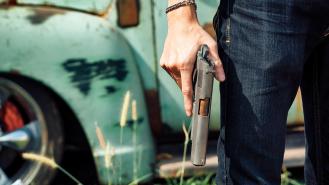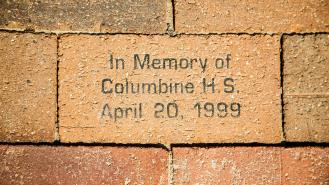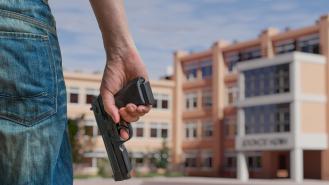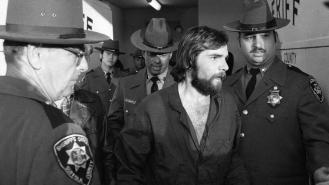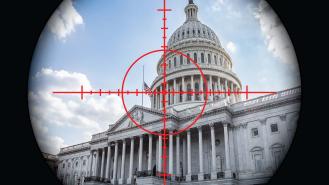
Dunblane: Two decades later
Dunblane is a close-knit town of around 10,000, located on the edge of the picturesque Scottish Highlands but still within close proximity to Scotland’s major cities. In 1996, this commuter town was the scene of a horrific mass shooting which would shatter the sleepy peace of the quaint town. The sense of disbelief and shock still reverberate across the nation, 25 years later, and would be instrumental in the introduction of the Firearms (Amendment) Act of 1997.
It was a crisp morning on the 13th of March, 1996. 43-year-old Thomas Hamilton was spotted by a neighbour at around 8:15AM as he scraped ice off his white van outside his home on Kent Road, Stirling. He was wearing black combat trousers, a dark jacket, and a dark woolly hat. A short while later, Hamilton drove in the direction of Dunblane. At around 9:30AM, he parked his van in the car park of Dunblane Primary School. He retrieved a pair of pliers that he had brought along with him and cut the telephone wires in the telephone pole in the school’s car park. This telephone pole did not serve the school but instead, a number of houses in the surrounding area.
Hamilton then donned a pair of ear defenders, grabbed a large black bag that he had brought with him, and attached four holsters to his body. In the bag and holsters, he was carrying four guns with 743 rounds of ammunition. He was armed with two Smith and Wesson revolvers and two high-powered Browning pistols. He walked across the car park and entered Dunblane Primary School through a door on the west side.
At 9:37AM, Hamilton entered the gymnasium which was filled with children from Gwen Mayor’s primary 1 class; there were 28 pupils in total, 25 of which were 5-years-old and three of which were 6-years-old. The children had just attended morning assembly, changed into their PE kits and then gathered inside the gymnasium for their first class of the morning: physical education. Eileen Harrild, the part-time physical education teacher at the primary school, had been laying out equipment when Hamilton entered. ‘The wee ones were always excited. I told them to stand, spaced out throughout the gym. With them was their teacher, Gwen Mayor. She was to be relieved in a few minutes due to a meeting with the headmaster,’ Harrild later said.
Before Harrild even had a chance to ask Hamilton who he was or why he was there, he opened fire. Harrild raised her arms and was shot in both forearms, the right hand and left breast. In a state of shock, Harrild managed to stumble towards the store room of the gymnasium. A number of terrified children followed her into the store room. As they attempted to seek out safety, Mayor was shot several times by Hamilton and died instantaneously while Mary Blake, a supervisory assistant, was shot in the head and legs but made it into the store room, ushering a number of children with her. Some of the terrified children inside the store room had been shot and the two teachers desperately attempted to console them as the shooting inside the gymnasium continued in rapid succession. Amy Hutchinson, who was just 5-years-old, later said: ‘We were skipping around. I don’t remember the pain of being shot. I don’t remember the noises. I don’t remember sounds. I remember my leg turning to jelly and falling to the floor.’
Hamilton had taken up three different positions in the gymnasium as he indiscriminately shot at the 28 children and three teachers. When he first entered the gymnasium, he spread his fire before walking towards the middle of the gymnasium and firing more rounds. Finally, he walked to the end of the gymnasium and fired from that angle. At one point, he walked in a semi-circle and systematically fired at a group of children who had either been injured by the shooting or had been pushed to the floor during the chaos and confusion. He then stood over the children and fired at point-blank range. As the horror was unfolding, a little boy who had been sent out to find a pair of scissors looked through the window of the gymnasium. He was spotted by Hamilton who fired through the window, injuring the boy with the shattered glass.
A teacher, who had been walking along a corridor in the main building of the school, was grazed in the head by one of the bullets. Hamilton then exited the gymnasium via a fire exit and fired towards the primary 7 portacabin classroom of Kay Gordon, who ordered her pupils to the ground. Nine bullets were fired at Gordon’s classroom, some of which passed through the walls of the classroom and one of which went through the back of a chair which just moments earlier, a child had been seated on. Miraculously, none of the pupils in this classroom were injured.
From here, Hamilton returned to the gymnasium and continued to fire. He would fire a total of 105 shots. Seven times during the sustained attack, Hamilton loaded and reloaded one of the Browning pistols. This pistol took 9mm parabellum cartridges which were sold without any markings to indicate top or bottom. Hamilton had etched his own markings onto the parabellum cartridges to speed up reloading times. He had also reloaded the parabellum cartridges using four different kinds of bullets.
Around five seconds after Hamilton re-entered the gymnasium, he switched the Browning pistol for one of the Smith and Wesson revolvers. He put the barrel of the gun into his mouth and pulled the trigger, ending his life surrounded in the bloodbath he had just created. In the space of just a couple of minutes, Hamilton had shot 32 people a total of 58 times. 16 of these people were killed inside the gymnasium, including Mayor and pupils in her primary 1 classroom. One child died on the way to Stirling Royal Infirmary.
The victims would be identified as: Victoria Elizabeth Clydesdale, 5, Emma Elizabeth Crozier, 5, Melissa Helen Currie, 5, Charlotte Louise Dunn, 5, Kevin Allan Hasell, 5, Ross William Irvine, 5, David Charles Kerr, 5, Mhairi Isabel MacBeath, 5, Brett McKinnon, 6, Abigail Joanne McLennan, 5, Emily Morton, 5, Sophie Jane Lockwood North, 5, John Petrie, 5, Joanna Caroline Ross, 5, Hannah Louise Scott, 5, Megan Turner, 5, and Gwen Mayor, 45.
As news of the lone gunman swept throughout the quaint community, parents rushed to the school gates. A senior police officer addressed the crowd, stating that he only wanted to speak to parents who had children in Gwen Mayor’s class. He directed the parents to a large home overlooking the school which they had been granted access to. The parents shuffled into the home, filling the kitchen, living room and hallway. After around an hour, the parents were all bussed to Dunblane Primary School where they were led into the staff room.
One by one, the parents were taken from the staff room and informed about what had happened; the parents of wounded children were called out first, followed by the parents of those who sadly had passed away. Isabel Wilson, the mother of Mhairi Wilson, would later recall the moment she found out her daughter had been killed in an interview with The Sunday Mail: ‘We went into the room with a police officer and a social worker. He said my daughter was one of the “casualties”. I learnt that he had two small daughters of his own and he couldn’t bring himself to say my daughter was dead.’
It would be theorised that Hamilton’s plan was to arrive at the primary school in time for morning assembly, which was held in the assembly hall just beside the gymnasium. Dunblane Primary School was one of the largest in Scotland, with 640 pupils. The assembly hall could not accommodate all of the pupils meaning that morning assemblies were limited to certain year groups in rotations. That morning, primary 1, 2, and 3 had attended morning assembly from 9:10AM to 9:30AM. Hamilton had missed morning assembly by a matter of minutes due to roadworks in the area.
In the wake of the murders, many media outlets scrambled to uncover who Hamilton was and what had caused him to snap with such brutality, against such innocent children. They would discover that Hamilton had been a relatively well-known face in the area where he was known as ‘Ho-Hum’ for his penchant for walking with his hands clasped behind his back. He had become increasingly rejected and isolated in the close community where he had become known for his interest in guns and young boys. Hamilton had briefly been a Scout leader but several complaints of inappropriate behaviour would be lodged against him including two occasions wherein boys had been ordered to sleep in close proximity to him inside his van during an expedition. In 1974, he was removed as a Scout leader due to concerns about his conduct with the young Scouts. Hamilton would be blacklisted by the Scout association which meant that he would be denied an appointment in the Scout Association.
Following this, Hamilton would attempt several times to return to the Scouts but was continually rebuffed. He then became increasingly involved in the setting up and running of boys’ clubs, including the Dunblane Rovers, the Dunblane Boys Club, and the Bannockburn Boys Club among many others. From 1981 until 1996, Hamilton had organised and operated 15 boys’ clubs, many of which were held on school premises
Whispers began to circulate around the area that Hamilton had an unhealthy obsession with boys and a number of parents would remove their boys from his clubs. Hamilton had taken hundreds of photographs and videotapes of young boys in his boys’ club, many of whom were wearing nothing other than swimming trunks. Desperately attempting to defend his image, he would send out letters to the parents denying the stories about him and would even petition politicians and authorities. Just the day before the massacre, Hamilton had mailed packages to television stations and newspapers which contained copies of letters in which he contended that he was ‘not a pervert.’ In fact, Hamilton had even written a letter to Queen Elizabeth II, complaining that he had been banned from the Scouts. His letter read in part: ‘I turn to you as a last resort and am appealing for some kind of intervention to help me regain my standing in society.’
The Dunblane Massacre would become a rallying cry to ban handguns in Britain, which had one of the most stringent gun control laws in the world. At the time, fewer than 5% of British home owners kept a gun. Duncan McLennan, the father of one of the victims, stated: ‘We can’t get our children back. We can do the best we can to make sure it doesn’t happen again. We should make sure no one dies from a legally held handgun again.’ Hamilton had owned the guns legally and had held a firearms certificate for over 20 years and he passed each periodic check on his fitness to keep weapons. Just the year beforehand, Scotland police renewed 340 firearm licenses, including Hamilton’s, and approved every single one.
Bereaved family members would initiate a campaign to ban private gun ownership and to keep guns for target practice kept under lock and key in clubs. It was called the Snowdrop Petition; the snowdrop was the only flower that bloomed in early spring when the victims were slain. The Snowdrop Petition would be signed by over 700,000 people and submitted to Parliament. In response to the outcry and despite overwhelming opposition from the wealthy and powerful gun lobby, the Firearms (Amendment) Act 1997 was introduced which banned all cartridge ammunition handguns with the exception of .22 calibre single-shot weapons in England, Scotland and Wales. Later that same year, Tony Blair’s Labour government introduced the Firearms (Amendment) (No.2) Act 1997, banning .22 calibre single-shot weapons as well.
The Dunblane Massacre remains the deadliest criminal act involving firearms in U.K. history but in the aftermath, the nation united to ensure that a tragedy of that magnitude would never happen again. The legacy of the victims of the Dunblane Massacre is that no child should feel afraid in school and since Thomas Hamilton’s deadly attack, the U.K. has not experienced another school shooting.
